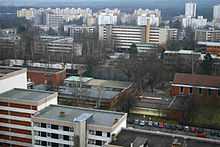Langwasser
| Langwasser | ||
|---|---|---|
| District of Nuremberg | ||
| ||
 Langwasser | ||
| Coordinates: 49°24′N 11°7′E / 49.400°N 11.117°ECoordinates: 49°24′N 11°7′E / 49.400°N 11.117°E | ||
| Country | Germany | |
| State | Bavaria | |
| Admin. region | Middle Franconia | |
| District | urban district | |
| City | Nuremberg | |
| Population (2005) | ||
| • Total | 47,588 | |
| Time zone | CET/CEST (UTC+1/+2) | |
| Postal codes | 90470-90479 | |
| Dialling codes | 0911 | |
| Vehicle registration | N | |
Langwasser is a district of Nuremberg in the southeastern area of the city. It was developed as a prototype of the satellite town concept in the 1960s and is primarily a suburban residential area. The name Langwasser (translated as "long water") comes from a small stream bordering the area on its eastern edge.
Location
Langwasser is located in the southeastern area of Nuremberg.
History
At the beginning of the 20th Century the area that would become Langwasser was heavily wooded and part of the Imperial Forest. After devastating forest fires between 1917 and 1919 the area was cleared and used for farming.
The Nazi Era
Prior to World War II, the area which had been cleared by fire became an important site for the Nazi movement. Beginning in 1934 it was the site of various tent cities and encampments. The area originally housed a tent encampment of the Reich Labor Service (RAD) and later the Hitler Youth (HJ). Permanent camps for the SS, SA, HJ, and RAD were built near the Nuremberg Rally Grounds. The Langwasser camp, with space for 200,000, was the largest. At the outbreak of World War II, party rallies ceased and the compound was converted into a prisoner-of-war camp known as Stalag XIII-D, which housed up to 150,000 prisoners until closing in 1940. In this camp during August 1940, prisoners of war celebrated a "special Olympics" called International Prisoner-of-War Olympic Games where prisoners of Belgium, France, Great Britain, Norway, Poland, Russia and Yugoslavia took part.[1] United States military records[2] report that 6,676 American POWs were transferred there late in the war.
The Post-War Period
The actual history of Langwasser as a district begins after the Second World War in 1949. For ten years the area was a mixture of refugee camps and temporary housing developments. Construction of the first permanent housing developments did not begin until the 1950s. Many German refugees from Silesia and from the Sudetenland made Langwasser their new home. The facilities were used as internment camp by the US occupation army. e.g.,during the Nuremberg Trials 21 witnesses - members of the SS - were moved to the camp on July 17 1946 from the Palace of Justice to the camp.
Modern Times
The modern history of Langwasser begins with the decision of the city of Nuremberg to develop a planned community in the area marketed with the slogan "living in the country". An architectural competition was held in 1956 with construction beginning the following year. Construction was not fully completed until the 1990s. A part of Langwasser Nordost around Euckenweg is apparently carfree, however with underground garages. [3]
Architecture


Langwasser is served by the U-Bahn (subway / underground train). Langwasser Süd is a Nuremberg U-Bahn station, located on the U1 and U11 lines.
| Preceding station | Nuremberg U-Bahn | Following station | ||
|---|---|---|---|---|
toward Hardhöhe |
U1 | Terminus | ||
toward Eberhardshof |
U11 |
Notes
This article was created as a student project as part of the Lexicon Franconian Translation Project.
References
- ↑ http://www.la84foundation.org/OlympicInformationCenter/OlympicReview/1996/oreXXV8/oreXXV8zza.pdf
- ↑ World War II Prisoners of War Data File, 12/7/1941 - 11/19/1946
- ↑ Ansicht des "autofreien" Bereichs in Google maps